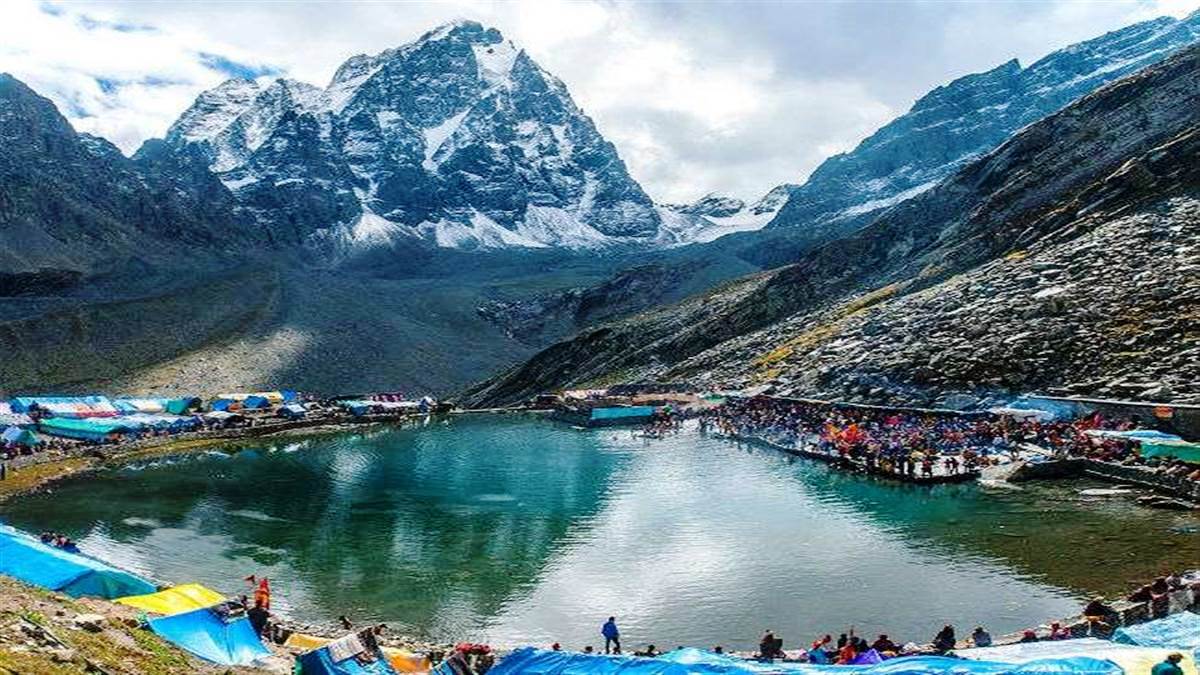Mani Mahesh Yatra is a state-level pilgrimage site of Himachal Pradesh. This Yatra takes place every year in August/September month. Government authorities take the responsibility of Yatra same as other famous Yatra like Kedarnath, Amarnath, etc. Manimahesh is not only the attraction for the devotee of Lord Shiva but also the trek lovers. In this blog, we will explore Manimahesh in and out.
About Mani Mahesh Yatra
• Spiritual Belief: It is believed that Lord Shiva did penance for many centuries at Mani Mahesh. Local people believe that Lord Shiva created this Manimahesh peak after marrying Goddess Parvati. People also believe that Manimahesh Kailash Peak is the second place where Lord Shiva resides in the shape of SHIVALING.
• Yatra Date: This is a 15 day Yatra. Every year Manimahesh Yatra starts on the day of Krishna Janmashtami and ends on Radha Ashtami. This year in 2021, Mani Mahesh Yatra will begin on 30th August and will end on 14th September.
• How to Reach:
By Road: – Buses are the most preferable medium of transport to reach Himachal Pradesh. You will get frequent AC/non-AC buses from Delhi to reach Chamba. These Buses will take minimum 16 to 17 hours to reach Chamba. This journey will be 580 km long. Bus fare for Chamba is Rs. 1600 to 1800 for AC buses and for non-AC buses its around Rs. 800 to 900.
From Chamba, buses are available for Hadsar via Bharmour. The distance between Chamba and Hadsar is around 78 km. Buses take 3-3.5 hr to reach Hadsar and cast Rs. 100 to 150. From Hadsar a 13 km long trekking for Mani Mahesh starts.
By Train: – Nearest railway station from Chamba is Pathankot, Panjab which is 100 km away. Pathankot railway is well connected with Delhi and other cities of India with prescheduled trains. From Pathankot, you will get direct Buses for Chamba which takes around 4 to 4.5 hr to cover 100 km distance. This is the most convenient and affordable because less on-road travel and involvement of train connectivity reduces cast to some extent.
By Air: – Chamba district does not have direct air connectivity. The nearest airport is Kangra airport which is 120 km from Chamba town. Kangra airport is connected with flights from Delhi and Chandigarh. From Kangra, you will get Buses for Chamba which will take around 4 hours.
Helicopter service is also available From Bharmour if you want to avoid a 13 km long trek. From Bharmour it takes 7 min. to reach Gouri Kund. This 7 min. the journey casts Rs. 3580 for both sides.
About Mani Mahesh Kailash Peak
Mani Mahesh Kailash is an invincible peak in the Pir Panjal Range of the great Himalaya. It is believed that this peak is the second place where Lord Shiva resides other than Kailash mountain. This belief is the sole primary reason that this peak contains “Kailash” in its name. This peak is also known as Chamba Kailash because this peak is situated in the Chamba district. The height of the Mani Mahesh is 5653 meters (18,547 ft). This peak is shorter in height than many other peaks on which mountaineers have climbed, like Mount Everest. But till date, no one has successfully climbed this peak. This peak has immense religious significance. This peak is just above Mani Mahesh Lake. Pilgrims do the Mani Mahesh Yatra in to get to see the Mani which appears on the top of this peak very rarely. This Mani is basically the reflection of light when the peak is not covered with the cloud and fog. It is believed that this reflection comes from the jewel of the crown of Lord Shiva.
About Mani Mahesh Lake
According to believers, Mani Mahesh Lake was created by Lord Shiva. This lake is situated at an altitude of 4080 meters (13000 ft) at the foot of Mani Mahesh Kailash Peak. This lake is 26 kilometers from Bharmour. This lake is small in size but it is a very significant pilgrimage site. Devotes do 13 kilometers trek by foot on difficult terrain to reach Mani Mahesh Lake. During Mani Mahesh Yatra pilgrims take a dip in the water of this holy Lake. After taking dip people walk around on the circumference of the lake. Mani Mahesh is also known as Dal Lake but don’t confuse it with the more famous Dal Lake which is in Shrinagar.
Legend
Almost every religious place has some popular legend. Mani Mahesh also has some popular legend. The most popular legend about this place is that it was created by Lord Shiva after marrying Goddess Parvati.
Another legend is about the Gaddi tribe. Gaddis is the local tribe of the Chamba district which resides in Gaddi Valley. By profession, Gaddis is the shepherd. It is believed that after creating the Mount Kailash Lord Shiva allowed Gaddis to become his devote. Lord Shiva gifted their traditional Chuhali Topi to the Gaddi tribe which they wear with Chola and Dora. After these events, Gaddis devoted themselves to shiva and called their land “Shiva Bhumi”.
Also, there are some stories about Manimahesh Kailash Peak. It is believed that this peak is invincible as no one has climbed this peak. There is a famous story of a Gaddi who tried to climb this peak with its sheep but he turned into stone along with its sheep. Another story is about a Snake who tried to reach at peak of Manimahesh Kailash and he also became a stone.
Geography
Mani Mahesh is an inhabitable place because of extreme weather conditions and the presence of snow for whole years. Manimahesh Lake is situated at a height of 4080 meters. Manimahesh is at the foot of the invincible Manimahesh Kailash. This place is a barren plain land. Manimahesh Lake glacier based small lake in that plain. This plain is called Shiva’s Chaugan which means playground of Lord Shiva. The valley on which this lake is situated is called Budhil Valley. Actually, Budhil is a river that found its way in between the valleys of Pir Panjal Range of the Himalaya. Budhil River is a tributary of the Ravi River. Budhil valley is also known as Manimahesh Ganga. Just in front of Manimahesh Lake, Manimahesh Kailash Peak is situated. This peak is also called Chamba Kailash. The Height of Chamba Kailash is 5653 meters. This peak is covered with snow but due to harsh weather, cloud, and fog, you also can’t see the peak generally. Manimahesh is a snow-rich region that results in the formation of many streams of water on the mountains. Bhudhil river which is a major river in the region itself is formed by the small streams that originate from the different parts of the Manimahesh Kailash. Geographically this region is a very volatile area. There is very much possibility of landslide. Unsettled soil and heavy snow cause very high instability and danger.
Lake and its precincts
Manimahesh Lake is a small lake with very little depth. This lake is situated just below the Manimahesh Kailash. This lake is almost all time stay covered with snow. Even after all this Manimahesh is a great inspiration for the devotees. It encourages them to do long trekking and get the privilege to complete Manimahesh Yatra.
This Lake is at the center of a snowfield. This snowfield is called Shiva’s Chaugan (playground of Lord Shiva). This snowfield is totally a snow desert. There is almost no existence of any flora and fauna in the precincts of the lake. This is an inhabitable place. People came only during Manimahesh Yatra. During Yatra, many people choose to spend one night which they do in tents around the lake. Near the lake, there is a marble sculpture of Lord Shiva. Pilgrims do worship that image with full faith.
Pilgrimage
Manimahesh Yatra is executed under the observation of the Himachal Pradesh government, the Manimahesh Pilgrimage committee, and several NGOs. Gaddi tribes lead this Yatra and perform all the rituals. For the Gaddi tribe, a Yatra to Manimahesh Lake is the holiest event. This is a 26 km Yatra from Bharmaur which includes 13 km of trekking.
Manimahesh Yatra starts from the famous Chaurasi Temple situated in Bharmaur. Bharmaur works as a base camp for pilgrims. The next step is Hadsar. Hadsar is 13 km from Bharmaur which is connected with road transport. Hadsar is a small town where the road transport ends and the trekking start. From Hadsar 13 km of trekking starts and the real challenge pilgrims face. People pass through very tough terrain. Stones, inclined path, and changing weather but all this fades away with the name of Lord Shiva. After Hadsar next stop is Dhanchho which is 6 km from Hadsar. After the full-day trekking people rest in the tents and eat food from the small food offering outlets. Pilgrims take rest for a night at Dhanchho. Manimahesh is still 6 km from here. The next day the pilgrims wake up energetically and travel the remaining 6 km and finally reach their destination.
FAQ:
Q.1 : How do I get to Mani Mahesh?
Answer: The easiest way to reach Manimahesh is to reach Pathankot which is the nearest railway station from Chamba district. After reaching Pathankot you will get frequent AC and non-AC buses for the Chamba district. From Chamba buses and taxies are available to reach Bharmaur and further to the Hadsar. Hadsar is the place where the road ends and your trekking journey starts. This trekking journey is 13 km long and Dhanchho is a resting point in between the journey of Manimahesh. The next day your trek will end on the Shiva’s Chaugan where Manimahesh Lake and Manimahesh Kailash are situated.
Q.2 : What is the story of Mani Mahesh?
Answer: It is believed that Manimahesh was created by Lord Shiva after marrying the Goddess Parvati. It is said that Lord Shiva has performed penance for many centuries on the bank of Manimahesh Lake. It is a popular belief that Manimahesh Kailash peak is the second place where Lord Shiva resides; 6 months in Kailash Mountain and 6 months in Manimahesh Kailash. The Manimahesh Kailash is invincible and no one has reached the top of it same as the Mount Kailash. Whoever tries to reach the top of it had become stone. People say that no one can reach the top without the will of Lord Shiva. Two stories are very famous about climbing the Manimahesh Kailash. First is that once a Gaddi tried to reach at the top with its sheep and him along with his sheep turned into stones. Another is about a snake that also turned into stone.
Q.3 : Is Mani Mahesh Yatra started?
Answer: No, not yet. For 2021, Manimahesh Yatra will start on 30th August and will end on 14th September.
Q.4 : What is Mani Darshan?
Answer: Main Darshan is a very rare event. It’s a privilege of doing Mani Darshan at Manimahesh. Mani Darshan is basically a rare event of the reflection of light from the peak of the Manimahesh Kailash. It is believed that this light is reflected from the jewel of the crown of Lord Shiva who is the presiding deity of Manimahesh.


